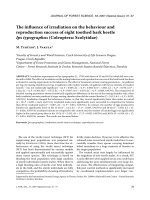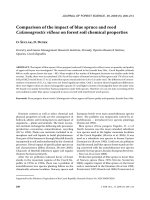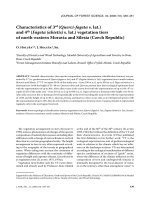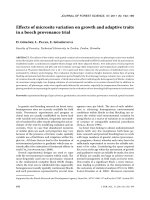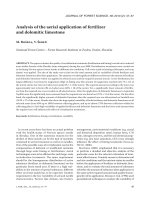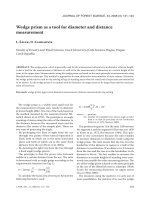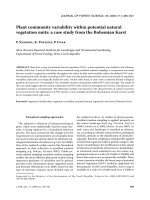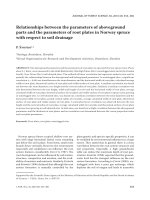Báo cáo lâm nghiệp: "Harvest scheduling with spatial aggregation for two and three strip cut system under shelterwood management" docx
Bạn đang xem bản rút gọn của tài liệu. Xem và tải ngay bản đầy đủ của tài liệu tại đây (997.13 KB, 7 trang )
J. FOR. SCI., 57, 2011 (6): 271–277 271
Harvest scheduling with spatial aggregation for two and
three strip cut system under shelterwood management
M. K
1
, R. M
2
, A. Y
3
1
Graduate School of Life Sciences, Tohoku University, Aoba, Sendai, Japan
2
Faculty of Forestry and Wood Sciences, Czech University of Life Sciences Prague,
Prague, Czech Republic
3
Department of Mathematical Analysis and Statistical Inference, The Institute of Statistical
Mathematics, Tachikawa, Tokyo, Japan
ABSTRACT: We propose a spatial aggregation method to solve an optimal harvest scheduling problem for strip shel-
terwood management. Strip shelterwood management involves either a two-cut system with a preparatory-removal
cut cycle, or a three-cut system with a preparatory-establishment-removal cut cycle. In this study we consider these
connected sequential cuts as one decision variable, then employ conventional adjacency constraints to seek the best
combination of sequential cuts over space and time. Conventional adjacency constraints exclude any spatially-overlapped
strips in the decision variables. Our results show the proposed approach can be used to analyze a strip shelterwood
cutting system that requires “connectivity” of management units.
Keywords: aggregation; connectivity; GIS; optimization model; spatial forest planning; wind-thrown risk
JOURNAL OF FOREST SCIENCE, 57, 2011 (6): 271–277
Supported by the Ministry of Education, Culture, Sports, Science, and Technology of Japan, Grant No. 18402003.
Forest managers are increasingly confronted with
complex and diverse management problems such
as the loss of biodiversity, disruption of ecosystem
services, and damage from natural disturbances. To
mitigate the damage- or risk-associated with these
management issues, it is often prudent to consider
allocation of management activities over space and
time because any management activity in a given
management unit could impact other spatially-re-
lated units. For example, natural disturbances such
as windthrow, fire, or insect infestation involve
spatial dynamics that can spread a damage-causing
factor over space and time. us, withholding cor-
rective management action on one site could in-
crease risk of loss on other sites.
Since the late 1980’s, increasing emphasis on
meeting ecological goals has pushed the devel-
opment of optimal forest management plans that
specify the location and timing of management
activities. Many studies have formulated spatial-
ly-constrained harvest scheduling problems that
search for spatial harvest patterns that prevent ex-
cessively large openings resulting from the harvest
of adjacent forest stands. Various mathematical
programming models for a spatially-constrained
harvest scheduling problem have been developed.
Early efforts include S and S
(1988), C et al. (1990), N and B-
(1990), Y et al. (1994), M and
C (1995).
is type of problem can be formulated and
solved using exact solution techniques by employ-
ing an adjacency constraint structure. However, as
the number of management units, planning peri-
ods, and exclusion periods increase, the number of
such constraints also increases and the problem be-
comes too large to be solved by the exact solution
techniques of integer programming. As a result,
several methods to reduce redundant adjacency
constraints have been proposed for solving adja-
cency constrained problems. For example, Y-
and B (1994) developed an algorithm
272 J. FOR. SCI., 57, 2011 (6): 271–277
objective is to maximize the total cut volume from all
forest stands over the planning period. Constraints
include land accounting, as well as spatial restric-
tions to avoid harvesting two adjacent strips during
the same period. Let
)
~
, ,
~
(), ,(
11 nm
xxxxX
=
′
=
be
an (m × n) dichotomous decision matrix with m
as
the number of stands and n as the number of treat-
ments for one stand, and ’ denotes the transpose,
where x
i
is the i-th row vector of
j
x
~
for the i-th
stand and
j
x
~
is the j-th column vector for the j-th
treatment. An element of X is thus defined by,
otherwise0
standth-ithefordimplementeistreatmentth-jtheif1
x
ji
,
1
Although Model I formulation by J and
S (1989) used a decision vector to meet the
general formulation requirements of linear pro-
gramming, we introduced a decision matrix to
clearly assign the treatment to strips by the row and
column of X. e objective here is given by,
,
where:
C – (m × n) coefficient matrix and its element,
c
i,j
– total volume obtained by the decision x
i,j
.
Given a planning period of 10, with six periods as
a minimum cutting cycle, Table 1 shows an exam-
ple of 20 treatments for one stand. e treatment
regime for one stand can be summarized as, “cut
the fifth strip in period three.”
To formulate land accounting constraints, which
require at most one treatment for each stand, we
have the following:
1'
n
x
i
≤ 1, i = 1, 2, …, m,
where:
1
n
– (n × 1) vector with a value of 1.
“No treatment” is also considered in the decision
variable.
Adjacency constraints prevent two adjacent
strips from being cut during the same period. Fol-
lowing Y and B (1994), we have:
, i = 1, 2, …, m,
where:
m
0
= A × 1
m
,
M = A + diag(m
0
).
and an element of the above adjacent matrix (A) is
defined by
where:
NB
i
– set of stands adjacent to the i-th stand.
to solve this type of problem using an adjacency
matrix. ey reduced the number of adjacency con-
straints by using matrix algebra and taking advan-
tage of the symmetric nature of the matrix. Early ad-
jacency studies focus on dispersion of harvest units.
If no large opening is created, fewer environmental
impacts are assumed to result from harvest activi-
ties (S, R 1997). Dispersion of harvest
units may well be dealt with by conventional adja-
cency constraints that prohibit harvesting any two
adjacent units simultaneously. Dealing with current
management issues, however, often requires explicit
consideration of spatial patterns, such as “connectiv-
ity” of management units that results from certain
vegetation relationships. For example, the connec-
tivity of old growth forests must be maintained to
protect corridors that constitute critical habitat for
certain wildlife species. In such a case, it is impor-
tant to consider not only directly adjacent units, but
also indirectly adjacent units that may be integral to
maintaining overall connectivity.
In this study, we propose a spatial aggregation
method to solve an optimal harvest scheduling
problem subject to “connectivity” requirements.
We formulate our approach as a spatial forest
management problem and apply it to strip shelter-
wood management, a forest management regime
commonly used in Europe (M 1989).
e strip shelterwood management regime speci-
fies the sequence of management activities, which
generally progress in a sequential fashion into the
prevailing wind. Most commonly applied shelter-
wood management regimes involve either a two-
cut system with a preparatory-removal cut cycle,
or a three-cut system with a preparatory-estab-
lishment-removal cut cycle, which progress from
windward to leeward. Under the three-cut system,
for example, the strip-by-strip cut cycle positions
a “preparatory cut strip,” “establishment cut strip,”
and “removal cut strip” over space and time. ere-
fore, the strips are lined-up from “preparatory cut
strip” to “removal cut strip” in a specific directional
order, which creates a spatial forest structure that
protects against wind damage (F 2001). We
utilize conventional adjacent constraints to formu-
late a strip aggregation optimization problem for
strip shelterwood management.
General problem specification
We formulate a simple spatially constrained prob-
lem within a 0–1 integer programming framework
without considering harvest flow. We assume the
1 if the j-th treatment is implemented for the i-th
0 stand otherwise
∑∑
= =
⋅=
′
=
m
1i
n
1j
) tr(max
j,ij,i
xcZ XC
X
×
0
~
mxM
j
≤×
1
i
i
,
NBjif0
NBjif1
ji
a
1
J. FOR. SCI., 57, 2011 (6): 271–277 273
Using the formulation above, we can allocate
treatments over space without harvesting adjacent
stands in the same period.
Demonstrative case study
We present an empirical example of the spatial
arrangement of aggregated strips to mitigate wind
damage risk. Our study site is part of a forest man-
aged by the School Forest Enterprise at the Techni-
cal University in Zvolen, Slovakia. e site consists
of six management units (MU) that are collectively
163.73 hectares (Fig. 1a). According to Slovak For-
estry Act No. 326/2005, these units should be man-
aged under a strip shelterwood silvicultural system
that supports natural regeneration. Under the strip
shelterwood system, MUs are first divided into a
strip window where the unit is harvested over the re-
generation period in a series of like-sized, uniformly
staggered linear strips that advance progressively
through units in one direction, most often into the
prevailing wind. Strip width is generally set at four
times the average dominant height of the target for-
est stand. For this site, a total of 58 strips were creat-
ed (Fig. 1b). e average size of these strips was 2.82
ha (min 1.04 ha, max 5.53ha). e strip shelterwood
management regime involves a two cut system with
a preparatory-removal cut cycle, or a three cut sys-
tem with a preparatory-establishment-removal cut
cycle. In either case, a cut cycle will progress from
the windward to leeward direction.
e two-cut system begins with a preparatory cut
for a windward strip. After a few years (e.g. five years),
a removal cut will be conducted in this strip and a pre-
paratory cut will simultaneously be implemented in
the leeward adjacent strip. A few years later, when the
removal cut for this leeward adjacent strip is complet-
ed, a continuous cut sequence (preparatory-removal)
will be initiated, starting from the strip adjacent to the
one where the removal cut is completed (Table 2). By
conducting the preparatory cut and removal cut in
two adjacent strips against the prevailing wind, this
system creates a spatial forest structure that mitigates
wind damage risk by gradually increasing average tree
height from the windward to leeward direction. If the
Table 1. Example of treatments
Treatment No. Decision variable Coefficient
Period
1 2 3 4 5 6 7 8 9 10
Treatment
1 x
i,1
c
i,1
X 0 0 0 0 0 0 0 0 0
2 x
i,2
c
i,2
X 0 0 0 0 0 X 0 0 0
3 x
i,3
c
i,3
X 0 0 0 0 0 0 X 0 0
4 x
i,4
c
i,4
X 0 0 0 0 0 0 0 X 0
5 x
i,5
c
i,5
X 0 0 0 0 0 0 0 0 X
6 x
i,6
c
i,6
0 X 0 0 0 0 0 0 0 0
7 x
i,7
c
i,7
0 X 0 0 0 0 0 X 0 0
8 x
i,8
c
i,8
0 X 0 0 0 0 0 0 X 0
9 x
i,9
c
i,9
0 X 0 0 0 0 0 0 0 X
10 x
i,10
c
i,10
0 0 X 0 0 0 0 0 0 0
11 x
i,11
c
i,11
0 0 X 0 0 0 0 0 X 0
12 x
i,12
c
i,12
0 0 X 0 0 0 0 0 0 X
13 x
i,13
c
i,13
0 0 0 X 0 0 0 0 0 0
14 x
i,14
c
i,14
0 0 0 X 0 0 0 0 0 X
15 x
i,15
c
i,15
0 0 0 0 X 0 0 0 0 0
16 x
i,16
c
i,16
0 0 0 0 0 X 0 0 0 0
17 x
i,17
c
i,17
0 0 0 0 0 0 X 0 0 0
18 x
i,18
c
i,18
0 0 0 0 0 0 0 X 0 0
19 x
i,19
c
i,19
0 0 0 0 0 0 0 0 X 0
20 x
i,20
c
i,20
0 0 0 0 0 0 0 0 0 X
X – harvesting while 0 denotes no harvesting
274 J. FOR. SCI., 57, 2011 (6): 271–277
regeneration period in this example is three 10-year
planning periods (30 years), the time spans between
preparatory and removal cuts is five years. en, two
cuts are completed within 10 years and the removal
cut is completed in five adjacent strips within the re-
generation period of 30 years.
e three-cut shelterwood system consists of a pre-
paratory, establishment, and removal cut. Like the
two-cut system, three sequential cuts must be com-
pleted within 10 years (within a regeneration period
of 30 years, the removal cut is completed on seven
adjacent strips). erefore, in this example, the time
span between each cut is three to four years. As in
the previous system, the sequence of three cuts (pre-
paratory, establishment, and removal) starts from the
windward strip (Table 3). With a time lag of three to
four years, the sequence of three cuts is initiated on
leeward adjacent strips. A few years later, another se-
quence of three cuts will be initiated on further lee-
ward adjacent strips. At the end of the first period –
for a given set of three adjacent strips – the removal
cut is completed on the most windward strip, the es-
tablishment cut on the middle, and the preparation
cut on the leeward strip. erefore, this system also
creates a height-sorted spatial structure by assigning
the cut sequence in each strip with a time lag.
e management goal of both systems is to main-
tain a spatial forest structure that protects stands
from wind damage while maximizing timber har-
vest. is shelterwood management problem can
be categorized as a spatially constrained harvest
scheduling problem, where a sequential cut over
space and time in adjacent strips is considered one
decision variable. Generally, for a given unit (the
focal unit), unit aggregation begins by connecting
each adjacent unit based on the wind direction.
en, strips are aggregated from a windward to
leeward direction with the most upwind strip set
as the focal strip. us, adjacency relationships
among strips are unidirectional (Fig. 2).
Mathematical programming formulation
In order to secure sequential cuts on adjacent
strips for risk mitigation during the regeneration
period, we aggregate five strips in one unit for the
two-cut system, and seven for the three-cut system.
en, we apply adjacency constraints to prevent
any two overlapped aggregated units from being
selected at the same time. Basically, this aggrega-
tion requires “connectivity” of strips. For example,
(a) (b)
Fig. 1. e study area landscape with management units
(MUs) (a), and with strips (b)
Table 2. Example of allocation and cutting progress of two-cut shelterwood system
Period
Wind ⇒
cut
strip
1 2 3 4 5 6 7 8 9 10 11 12 13
1
1 P P
2 R P R P P
2
3 R R R P R P
4 R P R P R P
3
5 R P R P R
6 R R
R – removal cut; P – preparatory cut
J. FOR. SCI., 57, 2011 (6): 271–277 275
in the case of the two-cut system, forest managers
must complete management activities for five con-
nected strips together. We additionally consider
constraints that prohibit cutting two adjacent fo-
cal strips at the same time. en, we search for an
optimal aggregation pattern that maximizes the
number of strips treated (minimizing the number
of strips left un-aggregated and un-managed), sub-
ject to spatial constraints. Given the management
objective described above, we formulate our strip
shelterwood scheduling problem using a 0–1 inte-
ger programming framework as follows:
Let a candidate of aggregated unit AU
j
be a set
of connected strips when aggregation starts from
any strip as a focal strip toward a leeward direc-
tion. Let us also define NB(i) as the index number
of a strip adjacent to the i-th strip against the pre-
vailing wind. en, after completing the recursive
operation four times – for the two-cut system – we
have the following set consisting of five strips:
AU
j
= {i, NB(i), NB(NB(i)), NB(NB(NB(i))),
NB(N(NB(NB(i))))}.
For the 1
st
, 2
nd
, and the 3
rd
strip in Fig. 1b – for the
two-cut system – we have the following:
AU
1
= {1, 2, 3, 4, 5}, AU
2
= {2, 3, 4, 5, 6},
AU
3
= {3, 4, 5, 6,7}, AU
4
= {3, 4, 5, 6,11}.
ere are a total number of 66 aggregated units
because strips 6 and 10 are branched – they are
connected to more than one strip (strip 6 is con-
nected to both strips 7 and 11, while strip 10 is
connected to strips 21 and 27; refer to Fig. 1b). As
a result of this branching, the number of decision
variables is greater than the total number of strips
in the unit. Note that the subscript for the aggre-
gated unit is conveniently specified so as to identify
all candidates. Likewise, for the three-cut system,
after completing the recursive operation six times,
we have a set of seven strips:
AU
j
= {i, NB(i), NB(NB(i)), NB(NB(NB,
NB(NB(NB(i))))))}.
For the 1
st
strip in Fig. 1b – for the three-cut sys-
tem – we have the following:
AU
1
= {1, 2, 3, 4, 5, 6,7}, AU
2
= {1, 2, 3, 4, 5, 6,11}.
e total number of the aggregated units is 70.
When we develop aggregated units for all strips,
some units overlap with others (as in Fig. 3). In other
words, a strip that is a member of the i-th aggregated
Table 3. Example of allocation and cutting progress of three-cut shelterwood system
Period
Wind ⇒
cut
strip
1 2 3 4 5 6 7 8 9 10 11 12 13
1
1 P
2 E P P
3 R E P E P
2
4 R E P R E P
5 R E P R E P
6 R E P R E P
3
7 R E P R E P
8 R E R E
9 R R
R – removal cut; P – preparatory cut
Figure 4: Adjacent structure
1
Fig. 2. Adjacent structure
276 J. FOR. SCI., 57, 2011 (6): 271–277
unit, AU
i
, will also be a member of another aggre-
gated unit. ese aggregated units cannot be chosen
simultaneously; therefore, in this study we exclude
overlapping units by applying conventional adjacen-
cy constraints with the following adjacency matrix:
A* = {a*
i,j
},
where:
Let us introduce the decision variable y
j
, for the
j-th aggregated unit.
en, assume that our objective is to maximize
the number of strips treated over the regeneration
period.
,
where:
w
j
– number of strips in AU
j
,
N – total number of the aggregated units.
By introducing the above objective function and
applying adjacency constraints, we can solve the
strip shelterwood management problem.
M* × y
j
≤ m
0
, i = 1, 2, …, m,
m
0
= A* × 1
N
,
M* = A* + diag(m
0
).
We use CPLEX (I 2003) to search for an
optimal aggregation pattern. Fig. 4a shows the
optimal solution that specifies the optimal spatial
pattern of the two-cut system. Following the opti-
mal aggregation pattern, 11 aggregated units were
selected for management and four strips were left
un-aggregated and un-managed. Each aggregated
unit consists of five adjacent strips except unit 52,
which contains four strips located at the lower end
of the study site.
Fig. 4b shows the optimal aggregation pattern for the
three-cut system. Seven aggregated units were select-
ed for management and 11 strips were left un-aggre-
gated and un-managed. Each aggregated unit consists
of seven adjacent strips except unit 28, which contains
5 strips located at the upper end of the study site.
Our results show that for both the two-cut and
three-cut systems, an aggregated unit with fewer strips
is also selected in the optimal aggregation pattern. is
is because our model considers unidirectional adjacen-
cy that limits the possible aggregation patterns on the
margins of the study site, but results in greater profit.
Comparing the two systems shows that the tighter
constraints necessary for aggregating seven strips
(as compared to five) results in more un-managed
strips. erefore, it is possible that less timber vol-
ume will be removed under the three-cut system.
Our experimental study demonstrates that the
proposed aggregation approach is a valid means of
solving spatial management optimization problems
designed to mitigate windstorm risk.
Concluding remarks
In this study we proposed a new spatial aggrega-
tion method to solve an optimal harvest schedul-
ing problem for strip shelterwood management in-
tended to mitigate windstorm risk. e proposed
ji
ji
ji
AUAU
AUAU
a
if0
if1
,
1
∑
=
=
N
jj
y
ywZ
1j
max
1
Overlapped
Overlapped
Overlapped
Overlapped
Figure 5: Overlapped strips
This figure was created using the programs Suppose (Crookston, N.L.) and SVS (
R.J.
McGaughey)
Fig. 3. Overlapped strips (figure was created using the programs Suppose – Crookston N.L. and SVS – McGaughey R.J.)
otherwise0
selectedisunitaggregatedth- theif1 j
y
j
1
1 if the j-th aggregated units is selected
0 otherwise
J. FOR. SCI., 57, 2011 (6): 271–277 277
method utilizes sequential strip aggregation for each
strip, and treats its aggregated unit as one decision
variable for optimization. As a result, the number
of decision variables becomes the same as, or more
than, the number of strips, depending upon how
many branches (i.e. aggregation patterns) exist from
one strip. In our case study, there were two strips
with two branched strips (strip 6 was connected to
both strips 7 and 11, while strip 10 was connected
to strips 21 and 27; refer to Fig. 1b). us the total
number of decision variables (66 for the two-cut
system and 70 for the three-cut system) was greater
than the total number of 58 strips. In the final so-
lution we applied ordinary adjacency constraints to
avoid sharing strips among aggregated units.
We demonstrated our approach using a case study
from a forest managed by the School Forest Enter-
prise at the Technical University in Zvolen, Slova-
kia. To reduce the risk of windthrow, adjacent strips
were aggregated unidirectionally in a windward to
leeward direction. us, strips were considered for
adjacency only if they were adjacent to the leeward
side of the previous strip. is is a special case of an
adjacent structure commonly used (such as “Moore
neighborhood adjacency”) where strips- or units-
sharing either lines or corners in any direction are
considered to be adjacent (C et al. 1996).
Dealing not only with stand adjacency, but also with
connectivity – or higher order adjacency – has been a
complex problem for forest managers. ough many
simulation approaches have been introduced for such
complex problems, an optimization framework has
not been proposed. Our approach would help formu-
late this complex spatial forest management problem
within the framework of a conventional spatially con-
strained optimization model, and solve it using inte-
ger programming with an exact solution method.
References
C W.M., R E.J., F W., L B., W H.
(1996): Transition rule complexity in grid-based automata
models. Landscape Ecology, 11: 257–266.
C S.E., D P.L., J M.S. (1990): An
operational spatially constrained harvest scheduling model.
Canadian Journal of Forest Research, 20: 1438–1447.
F T. (2001): Ecological and Silvicultural Strategies
for Sustainable Forest Management. New York, Elsevier
Science: 398.
I S.A. (2003): ILOGS CPLEX9.0 User’s Manual: 564.
J K.N., S T.W. (1987): FORPLAN version 2:
Mathematical Programmer’s Guide. Washington, USDA
Forest Service, Land Management Planning System Sec-
tion: 158.
M J.D. (1989): Silvicultural Systems. Oxford,
Clarendon Press: 284.
M A., C R. (1995): Heuristic solution ap-
proaches to operational forest planning problems. OR
Spektrum, 17: 193–203.
N J.D., B J.D. (1990): Comparison of a random
search algorithm and mixed integer programming for
solving area-based forest plans. Canadian Journal of Forest
Research, 20: 934–942.
S J., S J.B. (1988): SNAP – a scheduling and
network analysis program for tactical harvest planning.
In: Proceedings of International Mountain Logging and
Pacific Northwest Skyline Symposium. Corvallis, 12.–16.
December 1988. Corvallis, Oregon State University: 71–75.
S S., R C. (1997): Multiobjective grid packing
model: An application in forest management. Location
Science, 5: 165–180.
Y A., B J.D. (1994): Comparative analysis
of algorithms to generate adjacency constraints. Canadian
Journal of Forest Research, 24: 1277–1288.
Y A., B J.D., S J. (1994): A new
heuristic to solve spatially constrained long-term harvest
scheduling problems. Forest Science, 40: 365–396.
Received for publication May 19, 2010
Accepted after corrections March 21, 2011
Corresponding author:
M K, Tohoku University, Graduate School of Life Sciences, 6-3 Aoba-Aramaki, Aoba, Sendai,
980-8578, Japan
e-mail:
1
凡例
stripareaOpt
<その他 の値 すべて
>
optfive
1
9
20
24
30
37
42
47
52
56
61
9999
AU1
AU9
AU20
AU24
AU30
AU37
AU42
AU47
AU52
AU56
AU61
NotManaged
Aggregated Unit
Figure 6
Figure 4: Optimal aggregation pattern of two-cut system
1
stripareaOpt
<その他 の値 すべて
>
opts even
2
24
28
33
46
53
61
9999
Aggregated Unit
NotManaged
AU2
AU24
AU28
AU33
AU46
AU53
AU61
Figure 7Figure 5: Optimal aggregation pattern of three-cut system
(a) (b)
Fig. 4. Optimal aggregation pattern of two-cut system (a),
and three-cut system (b)
